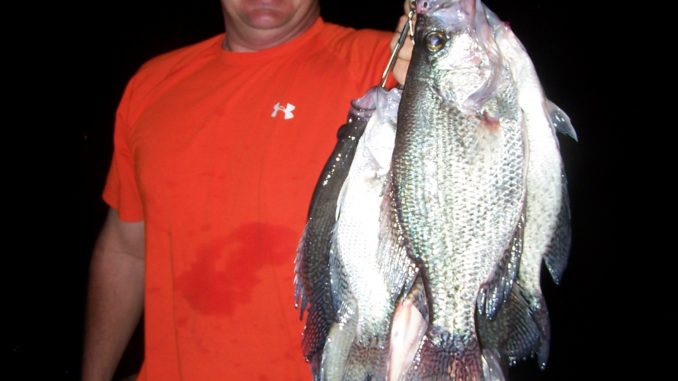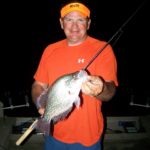
Pay attention to the thermocline, the location of baitfish and some current to find your summer crappie.
On any given lake, on any given night, particularly during the summer, there are a limited number of spots where a fisherman can go, tie up the boat and have a reasonable chance at catching a cooler full of crappie.
You can figure out how many of these places exist by counting the number of deep-water bridge crossings, multiply by the number of bays or open areas between bridges, then, depending on the size of the bridge, multiple that number by two: one for each side of the bay.
Wars have been started — well, maybe not wars, but more than a few heated exchanges — have occurred because one boat anglers got to a spot first or crowded another boat that was already on a favored spot.
Crappie guide and seasoned tournament angler Rod Wall of Ninety Six just laughs to himself. He spends his share of time year-round plying the darkness in search of crappie, but he has never gotten hung up on a particular location. He believes bridges make for great crappie cover, but during the daytime, not so much at night. That’s why he seldom goes to those places after dark.
“A bridge is always a good place to locate crappie because it is good structure,” said Wall, “but fish are more structure-oriented to a bridge during the day than they are at night. At night, crappie move around a lot more, and to find them, you need to look for an area that’s a bottleneck or funnel. Think about it in terms of deer hunting. You’ve got a 50- or 75-yard strip of wooded area between two fields. Deer move through the wooded area, and crappie move through open-water flats along a creek or river channel.”
Wall said bridges dictate that a bottleneck exists in a channel, and he’ll frequently fish the area, but he doesn’t feel like he has to be the first one to a particular spot. In fact, tying up to a bridge ties him down to a spot, good or bad. If he’s in a bad spot, it makes it that much harder to move.
“I very rarely anchor or tie up to any piece of structure anymore,” he said. “Even if you go fish a bridge and all the bays are taken up, don’t get frustrated. Back out 40 or 50 yards, put your lights out and instead of tying up, fish just outside of them. I actuality prefer that because I feel like I’m in jail if I’m tied to one bay. Once you get in there, you can’t move.”
It seems like every decade or so, Wall picks up one piece of gear to implement into his night-fishing regalia. He still uses the time-tested Coleman lantern, not to attract fish, but for light while he’s fishing. A decade or so ago, he added green, 12-volt lights to the corners of his boat — not the 4-foot, $200 variety but the smaller, $40 models you can find at a big discount store. The latest and greatest piece of equipment to make it into his arsenal is a trolling motor — actually, it’s a feature built into his new Minn Kota Terrova model.
“It’s the same trolling motor that runs off the iPilot remote,” he said. “It has a feature called Spot Lock. What that does is fixate on a certain GPS position, so if the wind blows you off the mark, the trolling motor will compensate by automatically cutting on, moving the boat back to the position and holding you in that general spot. I never have to anchor or tie up.”
“That’s also why I love to fish nights with 3 to 5 mph winds,” he said. “That’s just enough breeze to keep you cool and keep the bugs off, but it’s not blowing you off the water; you can stay, more or less, stationary.”
The remainder of Wall’s set-up is pretty standard for night-fishing. He uses B’n’M crappie rods in 7- to 9-foot lengths, 6-pound test line and single crappie hooks on a split-shot rig baited with live minnows. He does paint the tips of his rods with ordinary white primer spray paint, paying particular attention to the back of the spine. The white primer reflects the green glow and makes the rod tip shine so he can see when he’s getting a bite.
Of more interest than where Wall chooses his night fishing locations is why. He has a particular formula of water depth, clarity and water quality he feels gives him better odds for a successful night trip than just tying up to the same old bridge piling night after night.
“When night-fishing during the summertime, I’m going to target water that’s 45 to 70 feet deep, but I’m also looking for any kind of structure where fish will be able to hold at or above the thermocline,” he said.
“The thermocline will be at the same height or depth throughout the lake, except for the very uppermost ends where you’ve got water coming in,” said Wall. “I believe crappie will hold below the thermocline but not while actively feeding. Once a thermocline establishes on the local lakes, like Lake Greenwood or Clarks Hill, it’s typically going to be between 10 and 14 feet that I’ll catch active fish, but it may be over 70 feet of water with structure that comes up to 40 feet.”
Guide Brad Taylor of Taylor Outdoors also spends a number of summer nights fishing for crappie on Lake Murray. Like Wall, Taylor likes to fish the areas around bridges as well as under several of Murray’s more popular road crossings. When night-fishing, Taylor’s experience has shown him that crappie rarely feed all night.
“Typically, when I set up, I’m very confident that’s where I’m going to be,” he said. “If you know the fish are there, for the most part, they are going to bite. And you will catch those fish from dark to about midnight. Over the course of the night, all we’ll have time for is about two locations. Soon as the midnight bite shuts off, it’s time to move to another location, set up and start building your baitfish again because it seems like the next feeding period will cut on about 3:30 to 4 a.m. and last ‘til daylight.”
Like Greenwood and Clarks Hill, portions of Murray will stratify during the summer. Taylor suggests that’s another reason fishing bridges at night is so popular.
“Murray gets a thermocline during the summer, and that’s one good aspect of the whole bridge thing,” he said. “The water quality won’t be as bad because the bridges run over river channels that move water, so you’ve got a little bit of flow to help break that thermocline up.”
On the nights when Taylor doesn’t want to fight the crowds or if bridges are not producing, he will fish brush piles near the mid-lake area in the vicinity of Dreher Island.
“The best way to fish brush piles at night is to find fish on a brush pile right before dark and then double anchor over it, depending on how deep it is,” he said. “If you don’t want to worry about hanging up in the brush all night, you can anchor just to the side of it and then put the lights out. As it gets dark, those fish come off of that brush to feed on the baitfish in the lights.”
DESTINATION INFORMATION
HOW TO GET THERE — Night fishing for crappie during the summer on Lake Greenwood, Clarks Hill Lake and Lake Murray takes place under and around the mid-lake bridges or on structure that lines the main-river channel. For a complete listing of public access areas, consult the county boat ramp listing on the SCDNR website at www.dnr.sc.gov/pubs/boatfacilities.pdf
TACTICS/TECHNIQUES — The lion’s share of night-fishing for crappie is done from a stationary boat tied to a bridge or anchored on a drop-off. Whether drifting, stationary fishing or slow-trolling with a trolling motor, rods are placed in rod holders and baits, almost exclusively live minnows, are staggered at 2-foot intervals from four feet down to the thermocline. Artificial lighting is used to attract baitfish, which in turn draws crappie. Limber rods in 7- to 9-foot lengths and reels spooled with 6-pound test line will work fine for night-fishing.
GUIDES/FISHING INFO — Rod Wall, Slabmaster Guide Service, 864-993-8868 or www.slabmasterguideservice.com; Brad Taylor, Taylor Outdoors, 803-331-1354 or www.tayloroutdoors.com. See also Guides and Charters in Classifieds.
ACCOMMODATIONS — Greenwood Regional Tourism & Visitor Bureau, 866-493-8474 or www.visitgreenwoodsc.com; Hickory Knob State Park Resort, 800-491-1764 or www.southcarolinaparks.com/hickoryknob; Lake Murray Country Visitor’s Bureau, 866-SCJEWEL or www.lakemurraycountry.com.
MAPS — Navionics Electronic Charts, 800-848-5896 or www.navionics.com; Delorme South Carolina Atlas & Gazetteer, 800-561-5105 or www.delorme.com; Fishing Hot Spots, 800-ALLMAPS or http://www.fishinghotspots.com/.








Be the first to comment